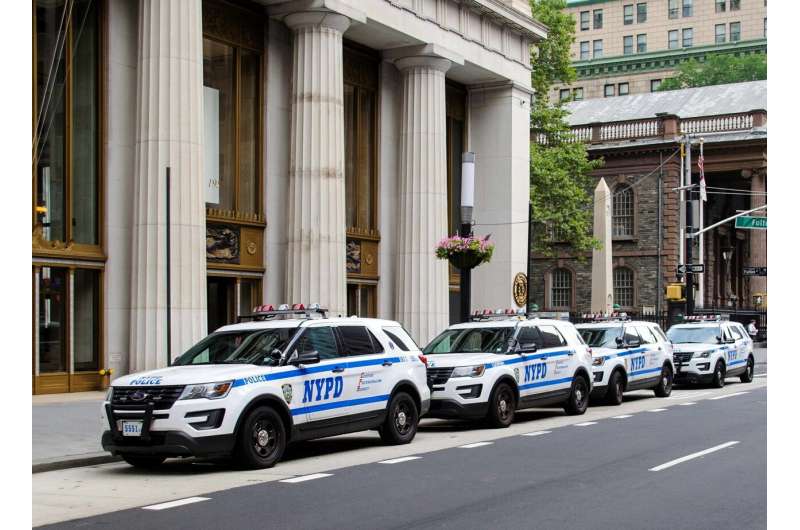This article has been reviewed according to Science X's editorial process and policies. Editors have highlighted the following attributes while ensuring the content's credibility:
fact-checked
peer-reviewed publication
trusted source
proofread
The NYPD gave officers iPhones—here's what researchers learned about race and policing

The controversy about biased policing seems to draw endless fuel from race-based differences in public perception. Simply put, the vast majority of white citizens in the United States believe the police are doing a good job, including on issues of racial equality, while a similar percentage of Black citizens hold the opposite opinion.
And while a growing number of studies have indicated persistent patterns of racial discrimination in policing, an emergent concern among scholars is that the data these papers rely on are also subject to baked-in biases, since they often derive from officers' self-reports of their own behavior.
Enter Brad Greenwood, professor of information systems and operations management at the Donald G. Costello College of Business at George Mason University. One of his research interests lies in how digital technologies are bringing unprecedented transparency to police practices. For example, Greenwood's 2022 paper documented how the introduction of body-worn cameras for the New York Police Department (NYPD) resulted in a significant reduction in abuse-of-authority complaints.
His latest work on policing is published in the Proceedings of the National Academy of Sciences. Along with Gordon Burtch from Boston University and Jeremy Watson from the University of Minnesota, Greenwood examined the recent rollout of iPhones across the NYPD, which included a series of digital tools designed to replace the handwritten memo books officers previously relied on.
Instead of scribbling in the physical books, which NYPD officers were required to hang onto even into retirement, officers could log their activities directly into a centralized database maintained by the NYPD. These detailed digital records shed fresh light on how cops spend their time—and attention—on the beat.
The researchers tracked data on NYPD stops and complaints in 2017 and 2018, the period when iPhones were being rolled out across precincts in New York City. A curious pattern emerged. There was an 18% increase in reported stops after a precinct received iPhones, which would be consistent with the digital tools making it easier for officers to report a citizen interaction.
Further, the researchers discovered that this increase resulted in neither more arrests nor more complaints from the public. It wasn't, therefore, that the phones were somehow causing the police to stop people more often, but rather that so-called "unproductive stops"—those leading to no further action—were being reported more often.
However, when breaking the results down across white and non-white citizens, the researchers found that unproductive stops involving non-white citizens were entirely responsible for the increase. In other words, the observed changes were based on police encounters with non-white members of the public that would likely have gone unreported in the days of pen and paper.
More specifically, after switching to the smartphone system, officers logged 22% more stops involving non-white citizens, while the number of reported stops of white citizens remained unchanged. These are statistical averages—the pattern was more marked in high-crime neighborhoods and those with a greater proportion of non-white residents.
Greenwood offered an interpretation of the finding, "The concern here is that we have an underreporting, which is concentrated in certain groups and means that we need to be cautious when interpreting prior work. On the one hand, it opens the door to bias in police interactions with civilians being worse than initially anticipated, at least based on the frequency of stops.
"On the other hand, it could mean that older data doesn't accurately reflect the likelihood of an arrest once a stop occurs. And we need to be doubly cautious, because we don't know if officers are reporting stops more frequently just because it is easier, or for some other reason."
Greenwood cautions against making sweeping conclusions based on the study. "The only thing we know for sure is that more and deeper work is needed by scholars and policy makers to ensure transparency between law enforcement and the people they are charged to protect," he said.
On the whole, however, the study raises the possibility that race-based disparities in policing are not only very real, but may have been underestimated thus far because of reporting gaps.
As police officers are not obligated to document all civilian interactions, their decisions regarding what—and what not—to report can be biased. The introduction of new technology, as in the case of the NYPD, can help counter such biases, but is not the only avenue worth pursuing. The researchers recommend that police departments "investigate the appropriate organizational complements (i.e., policies and procedures) necessary to uncover and eliminate such biases."
More information: Jeremy Watson et al, Do digital technologies reduce racially biased reporting? Evidence from NYPD administrative data, Proceedings of the National Academy of Sciences (2024). DOI: 10.1073/pnas.2402375121
Journal information: Proceedings of the National Academy of Sciences
Provided by George Mason University





















